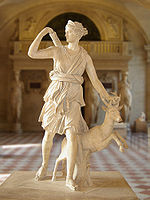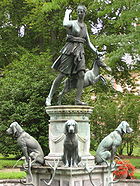
Diana of Versailles
Encyclopedia

Artemis
Artemis was one of the most widely venerated of the Ancient Greek deities. Her Roman equivalent is Diana. Some scholars believe that the name and indeed the goddess herself was originally pre-Greek. Homer refers to her as Artemis Agrotera, Potnia Theron: "Artemis of the wildland, Mistress of Animals"...
(Latin: Diana)
Diana (mythology)
In Roman mythology, Diana was the goddess of the hunt and moon and birthing, being associated with wild animals and woodland, and having the power to talk to and control animals. She was equated with the Greek goddess Artemis, though she had an independent origin in Italy...
, with a deer, located in the Musée du Louvre
Louvre
The Musée du Louvre – in English, the Louvre Museum or simply the Louvre – is one of the world's largest museums, the most visited art museum in the world and a historic monument. A central landmark of Paris, it is located on the Right Bank of the Seine in the 1st arrondissement...
, Paris
Paris
Paris is the capital and largest city in France, situated on the river Seine, in northern France, at the heart of the Île-de-France region...
. It is a Roman copy (1st or 2nd century AD) of a lost Greek bronze original attributed to Leochares
Leochares
Leochares was a Greek sculptor from Athens, who lived in the 4th century BC.-Works:Leochares worked at the construction of the Mausoleum of Maussollos at Halicarnassus, one of the "Seven Wonders of the Ancient World". The Diana of Versailles is a Roman copy of his original...
, c. 325 BC.
The statue is also known as Diana à la Biche, Diane Chasseresse ("Diana Huntress"), Artemis of the Chase, and Artemis with the Hind.
The statue was discovered in Italy: the Louvre website suggests Nemi
Nemi
Nemi is a town and comune in the province of Rome , in the Alban Hills overlooking Lake Nemi, a volcanic crater lake. It is 6 km NW of Velletri and about 30 km southeast of Rome....
, where there was an ancient sanctuary; other sources posit Hadrian's Villa
Hadrian's Villa
The Hadrian's Villa is a large Roman archaeological complex at Tivoli, Italy.- History :The villa was constructed at Tibur as a retreat from Rome for Roman Emperor Hadrian during the second and third decades of the 2nd century AD...
at Tivoli; in 1556 it was given by Pope Paul IV
Pope Paul IV
Pope Paul IV, C.R. , né Giovanni Pietro Carafa, was Pope from 23 May 1555 until his death.-Early life:Giovanni Pietro Carafa was born in Capriglia Irpina, near Avellino, into a prominent noble family of Naples...
to Henry II of France
Henry II of France
Henry II was King of France from 31 March 1547 until his death in 1559.-Early years:Henry was born in the royal Château de Saint-Germain-en-Laye, near Paris, the son of Francis I and Claude, Duchess of Brittany .His father was captured at the Battle of Pavia in 1525 by his sworn enemy,...
, with a subtle but inescapable allusion to the king's mistress, Diane de Poitiers
Diane de Poitiers
Diane de Poitiers was a French noblewoman and a prominent courtier at the courts of kings Francis I and his son, Henry II of France. She became notorious as the latter's favourite mistress...
. It was installed as the central feature of the Jardin de la Reine laid out west of the Galerie des Cerfs at Fontainebleau
Château de Fontainebleau
The Palace of Fontainebleau, located 55 kilometres from the centre of Paris, is one of the largest French royal châteaux. The palace as it is today is the work of many French monarchs, building on an early 16th century structure of Francis I. The building is arranged around a series of courtyards...
; there it was the most prominently displayed and among the first Roman sculptures to be seen in France. "Alone amongst the statues exported from Italy before the second half of the seventeenth century the Diane Chasseresse acquired a reputation outside Italy equivalent to the masterpieces in the Belvedere
Cortile del Belvedere
The Cortile del Belvedere, the Belvedere courtyard, designed by Donato Bramante from 1506 onwards, was a major architectural work of the High Renaissance at the Vatican Palace in Rome; its concept and details reverberating in courtyard design, formalized piazzas and garden plans throughout Western...
or the Villa Borghese
Villa Borghese
Villa Borghese may refer to:*The Villa Borghese Pinciana , the villa built by the architect Flaminio Ponzio , developing sketches by Scipione Borghese, who used it as a villa suburbana, a party villa, at the edge of Rome, and to house his art collection.**The Galleria...
" (Haskell and Penny 1981:196), though its admirers generally confused it with the Artemis of Ephesus
Temple of Artemis
The Temple of Artemis , also known less precisely as the Temple of Diana, was a Greek temple dedicated to a goddess Greeks identified as Artemis and was one of the Seven Wonders of the Ancient World. It was situated at Ephesus , and was completely rebuilt three times before its eventual destruction...
. In 1602 Henri IV
Henry IV of France
Henry IV , Henri-Quatre, was King of France from 1589 to 1610 and King of Navarre from 1572 to 1610. He was the first monarch of the Bourbon branch of the Capetian dynasty in France....
removed it to the Palais du Louvre
Palais du Louvre
The Louvre Palace , on the Right Bank of the Seine in Paris, is a former royal palace situated between the Tuileries Gardens and the church of Saint-Germain l'Auxerrois...
, where the Diana was installed in a specially designed gallery to receive it, the Salle des Antiques (now the Salle des Caryatides. At the time its restorations were revised by Barthélemy Prieur
Barthélemy Prieur
Barthélemy Prieur was a French sculptor.Prieur was born to a Huguenot family in Berzieux, Champagne . He traveled to Italy, where he worked from 1564 to 1568 for Emmanuel Philibert, Duke of Savoy in Turin...
. Replacing it at Fontainebleau was Prieur's bronze replica cast from it in 1605 (Haskell and Penny 1981:196), which was set upon a high Mannerist marble pedestal arranged by the hydraulics engineer Tommaso Francini
Tommaso Francini
Tommaso Francini, Thomas Francine in France, and his younger brother Alessandro Francini were Florentine hydraulics engineers and garden designers who worked for Francesco I de' Medici, Grand Duke of Tuscany, above all at the Villa Medicea di Pratolino, where Francesco de Vieri described the...
, with bronze hunting dogs and stag's heads spitting water by Pierre Briard, 1603, in a parterre
Parterre
A parterre is a formal garden construction on a level surface consisting of planting beds, edged in stone or tightly clipped hedging, and gravel paths arranged to form a pleasing, usually symmetrical pattern. Parterres need not have any flowers at all...
surrounded by an orangery
Orangery
An orangery was a building in the grounds of fashionable residences from the 17th to the 19th centuries and given a classicising architectural form. The orangery was similar to a greenhouse or conservatory...
Another full-size bronze replica was made in 1634 by Hubert Le Sueur
Hubert Le Sueur
Hubert Le Sueur was a French sculptor with the contemporaneous reputation of having trained in Giambologna's Florentine workshop, who assisted Giambologna's foreman, Pietro Tacca, in Paris, finishing and erecting the equestrian statue of Henri IV on the Pont Neuf...
for Charles I of England
Charles I of England
Charles I was King of England, King of Scotland, and King of Ireland from 27 March 1625 until his execution in 1649. Charles engaged in a struggle for power with the Parliament of England, attempting to obtain royal revenue whilst Parliament sought to curb his Royal prerogative which Charles...
, the brother-in-law of Louis XIII
Louis XIII of France
Louis XIII was a Bourbon monarch who ruled as King of France and of Navarre from 1610 to 1643.Louis was only eight years old when he succeeded his father. His mother, Marie de Medici, acted as regent during Louis' minority...
.
The Diana was installed in the Grande Galerie of Versailles
Palace of Versailles
The Palace of Versailles , or simply Versailles, is a royal château in Versailles in the Île-de-France region of France. In French it is the Château de Versailles....
by Louis XIV
Louis XIV of France
Louis XIV , known as Louis the Great or the Sun King , was a Bourbon monarch who ruled as King of France and Navarre. His reign, from 1643 to his death in 1715, began at the age of four and lasted seventy-two years, three months, and eighteen days...
. For Marly
Château de Marly
The Château de Marly was a relatively small French royal residence located in what has become Marly-le-Roi, the commune that existed at the edge of the royal park. The town that originally grew up to service the château is now a dormitory community for Paris....
a marble copy was executed by Guillaume Coustou in 1710.
As one of France's greatest treasures, the Diane Chasseresse returned to the Louvre in An VI of the First Republic
French First Republic
The French First Republic was founded on 22 September 1792, by the newly established National Convention. The First Republic lasted until the declaration of the First French Empire in 1804 under Napoleon I...
(1798). It was restored once more, in 1802, by Bernard Lange.

Chiton (costume)
A chiton was a form of clothing worn by men and women in Ancient Greece, from the Archaic period to the Hellenistic period ....
, a himation
Himation
A himation was a type of clothing in ancient Greece. It was usually worn over a chiton, but was made of heavier drape and played the role of a cloak.The himation was markedly less voluminous than the Roman toga....
around her waist, and sandal
Sandal (footwear)
Sandals are an open type of outdoor footwear, consisting of a sole held to the wearer's foot by straps passing over the instep and, sometimes, around the ankle...
s.
Comparable Roman replicas of the same model, noted by the Louvre's website, have been found at Leptis Magna
Leptis Magna
Leptis Magna also known as Lectis Magna , also called Lpqy, Neapolis, Lebida or Lebda to modern-day residents of Libya, was a prominent city of the Roman Empire. Its ruins are located in Khoms, Libya, east of Tripoli, on the coast where the Wadi Lebda meets the sea...
(Libya) and at Antalya
Antalya
Antalya is a city on the Mediterranean coast of southwestern Turkey. With a population 1,001,318 as of 2010. It is the eighth most populous city in Turkey and country's biggest international sea resort.- History :...
(Turkey).

